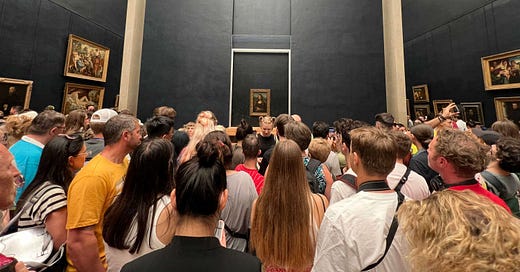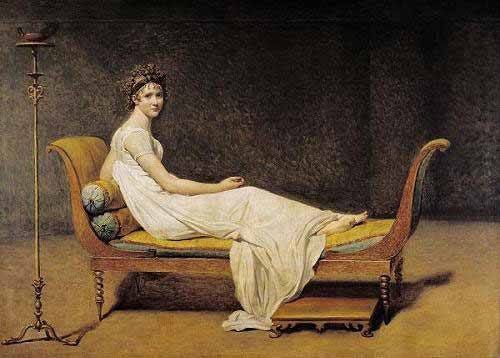Of the nearly nine million visitors who stream through the Louvre each year, it’s estimated that 80% are there for Leonardo da Vinci’s portrait of Lisa Gherardini del Giocondo, alias La Gioconde, aka the Mona Lisa.
It tells you something about her changing place in popular consciousness that the first time I stood in her physical presence, I was almost alone. That was early in 1969 - when, to be fair, Paris had other things on its mind. One couldn’t quite smell the tear gas but some streets were still torn up where rioting students had dug out cobbles to throw at les flics. Under those circumstances, it was hard to get serious about a 14th century portrait of a plump Italian matron with an unbecoming smirk.
Back then, one could stroll into the Louvre at one’s leisure, barely noticed by the drowsing guards, and cruise its treasures as casually and with as little interruption as had the Bourbons when this was a royal palace.
One could even sprint through its empty and echoing halls, like the trio of Jean-Luc Godard’s Bande à Parte. The game was to make the run while touching base at the museum’s three “greatest hits” – the Venus de Milo, the Winged Victory of Samothrace, and La Giaconde.
A witticism before each of them scored extra points. “I know the man who has the original,” said one man of the Leonardo. It wasn’t quite a joke. In 1911, an Italian workman who, ironically, had just built a new protective case for the painting, stole it, believing – incorrectly – that Napoleon looted it from Rome. (It was bought by Francois 1er, who welcomed Leonardo in his old age, granting him a pension, a chateau, and naming him “Premier Painter and Engineer and Architect of the King".) When the portrait resurfaced after two years, some experts felt the famous smile wasn’t quite as mysterious as they remembered, and a rumour circulated that copies could have been created to swindle unwary collectors. Might the work, now rehung in a special room off the main salon, even itself be a fake?
Nobody today thinks that – least of all President Macron, who, riding high on having - barely -fulfilled his promise of seeing Notre Dame restored by the end of last year (and anxious, say cynics, to bolster his failing authority), has just announced plans for the construction of a new gallery at the Louvre, with a separate entrance, exclusively for the Mona Lisa. Visitors interested only in that famous smile will be able to view it to the exclusion of all else, and no longer, as a British critic put it, “suck the oxygen from other art.”
The room where she’s currently housed was jammed when I visited the Louvre a few weeks ago. Barriers were needed to funnel people in and out. Dimly, over the heads of the crush, one could glimpse part of the armoured case that now imprisons her. I left them to it, passing on to visit some of my favourites - Jacques-Louis David’s 1800 portrait of a languidly reclining Judith Récamier, for example. The Jackie Kennedy of her day, arbiter of taste to a dying empire about to be shocked awake by Bonaparte, she regards us, arrogantly barefoot, from her Roman couch with a look of …. what? Speculate, philosophize, joke if you like about the Gioconda smile, but the gaze of Mme. Récamier…? There’s a true mystery. And I won’t be the only one of her admirers happier for being left in peace to contemplate it






I agree. There are few great art galleries where you can so often find yourself almost alone with a masterpiece. By contrast, the Orsay is almost always crowded, even congested. Of course the building is much smaller, but the atmosphere of intimacy is partly created by the organisers, who play up to it, with, for example, maze-like individual exhibitions that take place in lowered light.
The irony is that while the Mona Lisa room and certain other ones are jam-packed, there are others that you can still have all to yourself.